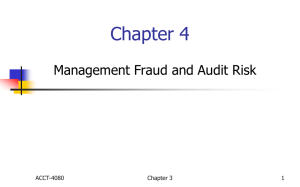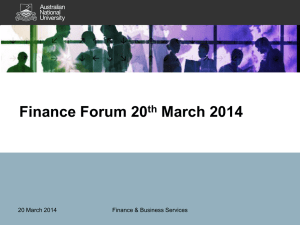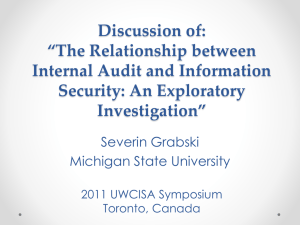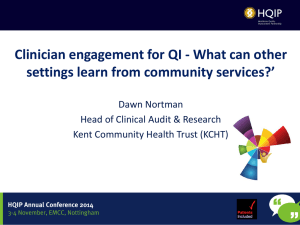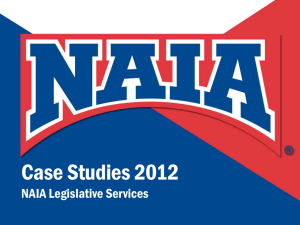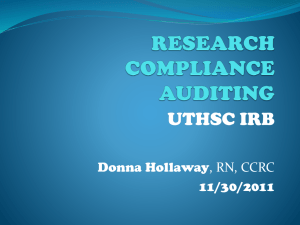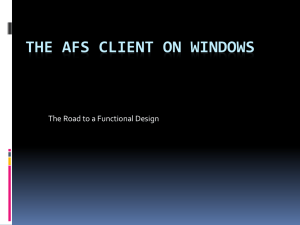LAFHA Update - Finance & Business Services
advertisement
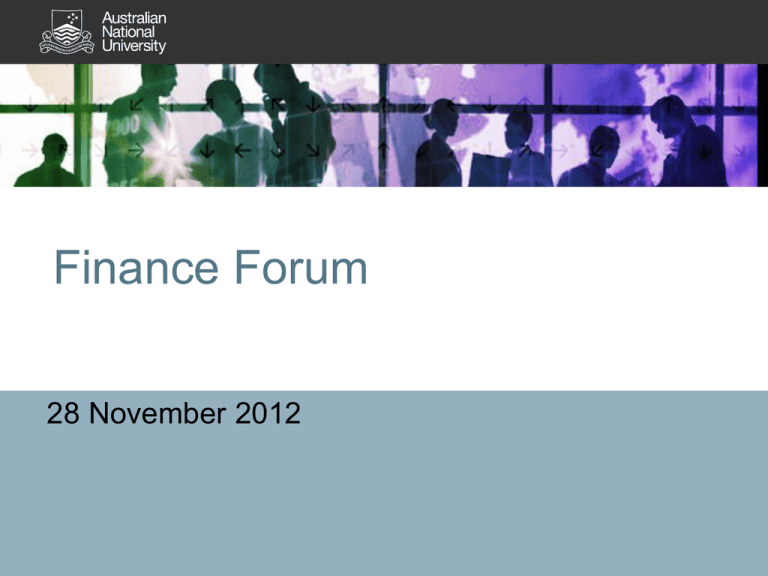
Finance Forum 28 November 2012 Welcome & Overview • David Sturgiss Overview • Welcome and Overview David Sturgiss • Update: F&BS Review David Sturgiss • ANU Risk Management and Assurance services Leslie Hyland • Morning tea • • • • • Chart of Accounts Review AFS 2012 2013 Budget Travel transactions - descriptions LAFHA – Update Peter Shipp Rachelle Conry Melissa Abberton Ron Robertson & Marg E Luke Beckett Update: F&BS Review The response from F&BS to the 2012 review can be found at: • About ANU, Administration reviews website or • accessed directly at: Implementation Plan (PDF, 134KB) F&BS Implementation Plan • F&BS has responded to all 16 recommendations; • The plan outlines the review recommendations, tasks associated with achieving the recommendations and identifies timeframes, Task/Project Manager, and Performance Indicator/progress. • The Implementation Plan is a high level summary of the actions that require implementation over the next six to twelve months. F&BS 2013 Operational Plan Specific details of related projects can be found in the F&BS 2013 Operational Plan which will be available on our website early next week at: Finance & Business Services » About F&BS (Projects specifically in response to review recommendations are numbered 1 -16/IP) Expected Outcomes of the Implementation Plan • Improved financial management reporting with greater data integration and enhanced utility by consistency in both reporting content and presentation; • Improved finance administrative management functionality and expertise across campus as a result of ensuring appropriate staff are recruited and placed in finance management positions with consistent Position Descriptions and Statement of Expectations and the delivery and engagement in the practice leadership program including staff rotations; Expected Outcomes of the Implementation Plan (cont) • Clarity around roles, responsibilities and delegations between Colleges and the Division; • Improved measurement in the outcomes of F&BS activities; • Financial benefits/savings to the University generally through the implementation of standardised service and product providers of basic commodities; • Improved communication strategy both within the Division and the University community more generally; and • By our engagement with the EDAP an improved and integrated whole of University framework for technology enabled business processes. ANU Risk Management and Assurance services • Leslie Hyland Risk Management & Audit Presentation to Finance Forum Presented by: Leslie Hyland Director of Risk Management and Audit, Office of the Vice-Chancellor November 28 2012 Objectives 1. The ANU Risk Awareness Framework— Enterprise Risk Management 2. The ANU Audit Program – Assessing Risk Management & Control Frameworks 3. ANU Governance – Risk Management and the Tone at the Top 4. Fraud Risk— ANU Fraud Control Framework 5. ANU ERM: Risk Management & internal Controls Integrated Framework & TEQSA : Next Steps 11 1. The ANU Risk Awareness Framework— Enterprise Risk Management 1.1 What is Enterprise Risk Management (ERM)? 1.2 ANU Risk Awareness Framework 1.3 Understanding the Three Categories of Risk 1.4 What is our Approach 1.5 Developing a Risk Management Plan – AS/NZS ISO 31000:2009 12 1.1 What is Enterprise Risk Management (ERM)? This is a structured and disciplined approach aligning strategy, process, people, technology and knowledge for the purpose of evaluating and managing uncertainties that the entity faces as it creates value. “This is one small step for man, one giant leap for mankind”. Neil Armstrong, Apollo 11 first moon walk, July 21 1969 13 1.2 ANUs Risk Awareness Framework ERM is not about being more risk averse. It is about being more risk aware. Risk Awareness Principles Protect against unforeseen loss RISK = THREAT Category 1 Risk = Preventable Risks Optimise Opportunities Ensure stability RISK = OPPORTUNITY RISK = UNCERTAINTY Category 2 Risk = Strategic Risks Category 3 Risk = External Risks 14 1.3 Understanding the Three categories of Risk The Three Categories of Risk Category 1= Preventable Risks Category 2= Strategic Risks Risks arising from within the entity that generate no strategic benefits Risks that are taken for superior strategic results Category 3= External Risks Risks that are external to the entity and therefore are uncontrollable Risk Mitigation Objective Avoid or eliminate occurrence cost-effectively Reduce likelihood and impact cost-effectively Reduce impact cost-effectively should risk event occur Control Approach Integrated culture-and-compliance model Develop mission statement; values and belief systems; Standard operating procedures; Internal controls; Internal audit Interactive discussions about risks to strategic objectives drawing on tools such as: Maps of likelihood and impact of identified risks; Key risk indicator scorecards; Resource allocation to mitigate critical risk events “Envisioning” risks Risk assessments and “stress testing; Scenario & simulation planning Role of Risk Management Staff Coordinates, overseas, and revises specific risk controls with internal audit function Runs risk workshops and risk review meetings; Helps develop portfolio of risk initiatives and their funding Acts as “devil’s advocate” Runs stress-testing, scenario & simulation planning with management team; Acts as “devil’s advocate” Relationship of the Risk Management Function to Business Units Act as independent overseers Act as independent facilitators, independent experts, or embedded experts Complements strategy team as independent facilitators of “envisioning” exercises By Robert S. Kaplan & Anette Mikes, Harvard Business School 15 1.4 What is our approach? A consistent approach to risk management across the university and at all levels of operations ANU Wide Risks • Enterprise wide view of risks facing the ANU: ANU Risk Profile • Risk profiles for ANU Colleges & Service Divisions • Risk profiles for Halls of Residences College / Division Risks • Risks assessments as part of grant applications and project initiation documents Projects & Grants “Risk Management is not intuitive; it runs counter to many individual and organizational biases. Rules and compliance can mitigate critical risks but not all of them. Active cost-effective risk management requires managers to think systematically about the multiple categories of risks that they face so that they can institute the appropriate processes for each. These processes will neutralize their managerial bias of seeing the world as they would like it to be rather than as it actually is or could possibly become.” Robert S. Kaplan and Anette Mikes, Harvard Business School 16 1.5 Developing a Risk Management Plan – AS/NZS ISO 31000:2009 Risk Management Process • Studies have found that people overestimate their ability to influence events, and that there is a tendency to be overconfident about the accuracy of forecasts and risk assessments and far too narrow in assessment of the range of outcomes that may occur. • Organizational biases also inhibit people’s ability to discuss risk and failure. There is a tendency to normalize deviations as people learn to tolerate apparently minor failures and defects and treat early warning signals as false positives. • Effective risk management must counteract the above biases. It must allow the establishment of a risk culture that enables people feeling comfortable thinking and talking about risk. • Effective risk management enables people to talk about strategy by challenging existing assumptions and debate risk information. Establishing the context Risk Assessment Risk Identification Communication and Consultation Monitoring and Review Risk Prioritisation Risk Response Risk Treatment 17 1.5 Developing a Risk Management Plan – AS/NZS ISO 31000:2009, continued 4 Steps: i. Risk Identification Think broadly about the risks associated with the project, grant and/or activity. Elements include: Risk category, Risk description, Risk owner, Cause of risk. ii. Risk Prioritisation Using the risk rating criteria, assess the probability of the risk occurring (likelihood) and the consequence of the risk occurring (impact). Start by assessing the current risk, then determine the residual risk. The current risk is the risk facing the entity, project and/or grant at the moment, with operations running as ‘business as usual’ prior to being treated. The residual risk is the risk remaining after all treatment strategies have been put in place. 18 1.5 Developing a Risk Management Plan – AS/NZS ISO 31000:2009, continued iii. Risk Response—What is being done to manage the Likelihood &/or Consequences of the risk (strategies, policies, procedures, reviews, inspections etc.) should be directed towards the previously identified cause(s) of that risk . The response could be: Avoid – do something to remove the risk Transfer – make someone else (e.g. vendor) responsible Mitigate – take actions to lessen the impact or likelihood of risk occurring Accept – stakeholders (including the appropriate delegate) may agree that the risk is at an acceptable level that the effort to take further action is not worthwhile iv. Risk Monitoring—Establish an Action Plan to continually monitor risks to identify any changes in status and add/remove risks “Risk mitigation is painful, not a natural act for humans to perform.” Gentry Lee, Chief Systems Engineer, Jet Propulsion Laboratory (JPL), NASA. 19 Categories included within the most up-todate of the organization’ s Risk Exposure Profile, for example Strategic, Reputational /Brand, Marketrelated, People, Ethical, Operational, Environment al, Funding, etc. This is a brief description of the risk being analysed This is the official with overall accountabilit y for managing noted risk It is important to know the cause(s) of a risk in order to develop strategies to manage that risk e This is an assessment of how likely the risk is to occur before strategies and/or controls are in place e.g. Unlikely to Almost Certain, based on Risk Ranking in use by the entity This is an assessment of the impact if the risk occurred e.g. Minor to Significant, and this can be in financial reputational, personal safety, etc. terms A predetermined scale (matrix) gives a risk rating from Minor to Severe based on these (see previous) Likelihood & Consequence assessments What is being done to manage the Likelihood &/or Consequence s of the risk is shown here and these actions (strategies, policies, procedures, reviews, inspections etc.) should be directed towards the previously identified cause(s) of that risk This is a reassessment of how likely the risk is to occur now, after strategies and/or controls are in place and their effective ness is considered This is a reassessment of how serious the impact now is, again, after the existing controls are considered Using the same scale as previously, the ‘leftover’ risk is now rated for acceptability or to indicate that further action is required Action Plan Residual Risk Rating Risk Consequence Risk Likelihood Management Controls on Risk Inherent Risk Rating Risk Consequence Risk Likelihood Cause of Risk Risk Owner Risk Description Risk Category 1.6 Risk Management Plan Elements If further action is required (i.e. the level of risk remains un-accept able even after strategies and/or controls are in place), that action is shown here along with the responsible entity & timeframe for action 20 2. The ANU Audit Program – Assessing effectiveness of operations, risk management, control and governance processes through the following activities: 2.1 Internal Audit –What we do and its relationship to ERM 2.2 External Audit– Value Proposition 2.3 Audit Follow-Up– Maturity of ERM 2.4 The ANU Audit & Risk Management Committee 21 2.1 Internal Audit • Conducted under the Professional Standards contained in the International Standards for the Professional Practice of Internal Auditing issued by the Institute of Internal Auditors, and the Accounting Professional Ethical Standards Board. • Guided by a Charter • Systematic and disciplined approach • Risk-based annual Internal Audit Plan and audit engagements, including compliance-based assurance audits, performance improvement audits, advisory audits and comprehensive audits. • Internal Audit Plan topics are selected on the basis of interviews key University stakeholders and evaluation of prior year (s) audited topics and results. 22 2.1 Internal Audit & ERM Core Internal Audit Roles Regarding ERM: Legitimate Internal Audit Roles with Safeguards: Giving assurance on the risk management processes Facilitating identification & evaluation of risk Giving assurance that the risks are correctly evaluated Coaching management’s response to risk Evaluating risk Management Processes Co-ordinating ERM activities Evaluating the reporting of key risks Consolidate report on risks Reviewing the management of key risks Maintain & develop ERM framework Roles that Internal Audit Should Not Undertake: Champion establishment of ERM Setting risk appetite Developing RM strategy for Council approval Imposing Risk Management Processes Management assurance on risks Taking decisions on risks responses Source: Institute of Internal Auditors (IIA) Implementing risk responses on management’s behalf Accountability for risk management 23 2.2 External Audit – Value proposition: Enhancing Sound Governance • Australian National Audit Office (ANAO) annual financial statement audit certification (provided in the form of the ANAO audit opinion)—the external audit provides independent assurance that University financial statements are properly prepared in accordance with set standards in all material respects. • Grant funding sponsors audit requirements: external auditors are engaged to evaluate the University’s compliance with set funding sponsors’ agreed-upon standards. The engagement is equivalent to that done through the Internal Auditor. The difference here is the oversight of the audit is done by an external audit manager. • Australian Commonwealth Government Entities’ Compliance Audits • The United States Government Financial and Compliance Audits • The European Commission Compliance Audits • Other entities funding ANU operations 24 2.3 Audit Follow-Up: Maturity of ERM • ANU is obligated to address/resolve audit-related findings in accordance with requirements set by the Australian National Audit Office (ANAO), Grant funding sponsors including the Australian Commonwealth Government Entities, The United States Government, The European Commission, other as appropriate • Progress towards resolution is monitored & reported to the Audit & Risk Management Committee and Council. • Audit findings are risk-rated per set risk rating guidelines endorsed by the Risk Management & Audit Office as it relates to “inherent risk” and “residual risk”. 25 2.4 The ANU Audit & Risk Management Committee (ARMC) • The Commonwealth Authorities and Companies Act 1997 (the CAC Act) obliges the University to have an Audit Committee. • The Audit and Risk Management Committee advises the University Council on the quality of audits conducted and the adequacy of administrative, operating and accounting controls and compliance with relevant legislation and policies. • The committee also oversees risk management planning and implementation. • The committee consists of five non-executive members, of which at least one is a member of Council. • The Audit and Risk Management Committee Charter outlines the roles and responsibilities of the committee, is approved by Council and reviewed annually. 26 3. ANU Governance – 3.1 Risk Management and the Tone at the Top 3.2 Risk Management and Going beyond the basics 27 3.1 Risk Management and the Tone at the Top • The “tone at the top” plays a critical role in establishing and maintaining ethical and accountable work environments within an organization; • The tone at the top is the ultimate responsibility of the organization’s leadership, lead from the top, by giving consistent messages on the importance of quality, shared at every level. • The ANU Governance framework includes Legislation, Policies, Delegations that are overseen, managed and implemented through: • Council • Committees of Council ( Audit & Risk Management Committee, Finance Committee, Academic Board) • University Committees • University Management “An entity’s ability to weather storms depends on how seriously executives take risk management when the sun is shining and no clouds are in the horizon.” Robert S. Kaplan and Anette Mikes, Harvard Business School. 28 3.2 Risk Management and going Beyond the Basics • • The Basics-- the ANU invests in rules-based risk management system that has worked well in aligning values, risks and controls Going Beyond the Basics– • ANU by 2020, the Strategic Plan, is the vehicle by which the university has identified its overarching strategic goals • The ANU Operational Plans are the vehicle towards managing inherent strategic and operational choices and/or the risks that are posed by internal and external environments • Managing risk is very different from managing strategy; the former focuses on the negative, such as failures rather than opportunities and successes. It runs exactly counter to the “can do” culture most leadership teams try to foster when implementing strategy. “When Tony Hayward became the CEO of BP, in 2007, he vowed to make safety his top priority. Among the new rules he instituted were the requirements that all employees use lids on coffee cups while walking and refrain from texting while driving. Three years later, on Hayward’s watch, the Deep-water Horizon oil rig exploded in the Gulf of Mexico, causing one of the worst man-made disasters in history. A U.S. investigation commission attributed the disaster to management failures that crippled “the ability of individuals involved to identify the risks they faced an to properly evaluate, communicate, and address them.” Robert S. Kaplan and Anette Mikes, Harvard Business School. 29 4. Fraud Risk— ANU Fraud Control Framework 4.1 What is Fraud 4.2 Types of Fraud --Examples 4.3 Fraud Prevention 4.3.1 Leadership and Culture –ANAO Better Practice Guide 4.4 Fraud Detection 4.4 Responding to Detected Fraud 30 4.1 What is Fraud? The ANU has adopted the following definition of fraud as advocated by the Australian Commonwealth Government’s Fraud Control Guidelines 2011: “Dishonestly obtaining a benefit, or causing a loss, by deception or other means” “ The ANU will seek to prosecute those who perpetrate frauds against it.” Risk Management and Audit , Fraud Control Procedure, 2012 31 4.2 Types of Fraud—Examples Manipulation of records; Theft of inventory, plant and equipment; False invoicing by a staff member or a person external to ANU claiming payment for goods or services not delivered or exaggerating the value of goods or services delivered; Theft of cash or funds other than by false invoicing; Any form of cheating; Conflict of interest; Misappropriation or misdirection of remittances received from a debtor; Loan application to student made in a false name and false documentation; Theft of intellectual property; Falsification of research results; Financial fraud involving grant funds; Engaging in transactions of self interest rather than interests of the entity; Lack of employment screening controls; Nepotism and cronyism when employing personnel; Falsification of qualifications; Collusive tendering; Falsification of financial transactions; For additional examples please follow this link: http://policies.anu.edu.au/procedures/fraud_control/procedure 32 4.3 Fraud Prevention—Attitude to Fraud—Zero Tolerance Elements in the ANU Fraud Prevention Framework: • • • • • • • • Code of Conduct ANU Fraud Control Plan & Procedure Fraud Risk Profiling and Management Activities Control Framework: ANU Policies, Procedures, Guidelines and Monitoring Activities conducted at all levels Internal Audit External Audit Continuous Monitoring Program through computer assisted audit techniques Fraud Control Booklet—”Protecting ourselves from Fraud” • http://risk.anu.edu.au/docs/Staff_Fraud_Booklet.pdf “A ‘top-down’ and ‘bottom-up’ approach to fraud control can help ensure an organisation’s policies, governance structures and processes for managing fraud risks are consistent and mutually reinforcing.” ANAO Better Practice Guide 33 4.3.1 Leadership and Ethical Culture Leadership and Culture Key Points: • Strong executive leadership is integral to effective fraud control within organizations • If staff perceive that controls to respond to fraud are not robust or supported by management, they are much less inclined to report it • To keep astride of emerging fraud risks, the entity must embed fraud control prevention activities into its day-to-day activities at all levels • The establishment of an ethical culture is a key element of sound governance and plays an important role in preventing fraud and helping to detect it once it occurs Governance: Policy & Legislation Prevention, Detection, Response, Monitoring, Evaluation and Reporting Fraud Control Strategies “When it comes to leadership, we can take comfort that nobody is perfect but there are accepted norms to guide us.” Ian McPhee, Auditor General of Australia 34 4.4 Responding to Detected Fraud---Key Points • • • • • • Fraud investigation and response are key to providing stakeholders with reasonable assurance that perpetrators of fraudulent acts are identified, and appropriate remedies are consistently applied. Australian Government entities are required to comply with the Fraud Control Guidelines which meet minimum standards for investigations set out in the Australian Government Investigations Standards. Under the Fraud Control Guidelines, entities are required to investigate minor and routine instances of fraud, irrespective of whether the outcome of the investigation results in an administrative remedy or is referred for prosecution consideration. Matters involving serious and complex fraud must be referred to the Australian Federal Police. Prosecutions are important in deterring future instances of fraud and in educating the public generally about the seriousness of fraud. Entities should be committed to recovering financial losses caused by fraud through proceeds of crime and civil recovery processes or administrative remedies. “ Character is like a tree and reputation like a shadow. The shadow is what we think of it; the tree is the real thing”. Abraham Lincoln, President of the United States of America (1861-1865) 35 5. ANU ERM: Risk Management & Internal Controls Integrated Framework & TEQSA : Next Steps Photo source, NASA 36 5.0 TEQSA: Regulatory Risk Framework & Impact to the ANU Risk Management Framework - TEQSA is being incorporated to the ANU Risk Management Framework, to acknowledge its existence - Risk Management Policy, Procedures & Tools are being updated to reflect the existence of the TEQSA Framework - ANU Internal Audit Planning Approach is being informed with TEQSA Regulatory Risk Framework & enable coverage in 2013 audit assurance activities, consistent with the ANU ERM approach 37 5.1 ERM View: Integration of Risk Management & Internal Controls: the COSO Integrated Framework • The Committee of Sponsoring Organizations of the Treadway Commission (COSO) is a joint initiative of five private sector organizations dedicated to providing thought leadership through the development of frameworks and guidance on enterprise risk management, internal control and fraud deterrence. http://www.coso.org/ • COSO Integrated Framework assists U.S. entities (Governmental and Corporate) better control enterprise-wide operations. • The elements of the COSO framework are in all types of entities and therefore its applicability across sectors. • Integrated internal controls can help entities achieve its performance and profitability targets, and prevent loss of resources. Internal control cannot ensure the entities’ success, but can at the very least help achieve basic success and potentially its survival. There is a fourth dimension to the above representation of ERM: the data that informs, in an integrated way, every aspect of the organisation’s Strategic , Operational, Reporting and Compliance activities. Successful organisations are those that are “data rich and information rich”, as opposed to “data rich and information poor”. 38 References: 1) 2) 3) 4) ANU Risk Management & Audit website--http://risk.anu.edu.au/ Managing Risks: A New Framework, by Robert S. Kaplan and Anette Mikes, Harvard Business Review, June 2012 Australian National Audit Office (ANAO) Better Practice Guide: Fraud Control in Australian Government Entities, March 2011 COSO Integrated Framework 39 Morning Tea Recommence in 20 minutes Chart of Accounts Review • Peter Shipp Currently a review of some natural account codes is underway. College/Division Finance Managers are participating in this process. A small number of changes are anticipated for 2013. AFS 2012 • Rachelle Conry AFS 2012 • Year End Systems Timetable • Year End made easy AFS 2012 • http://fbs.anu.edu.au/reporting/financialreporting/annual-financial-statementbasics – AFS Pack 2012 - Instructions – AFS Pack 2012 - Schedules – Year End journal rules – Accounting periods 2013 – Year End system dates 2012 44 AFS 2012 – Systems Timetable • Friday 7 December: – Plant & Equipment Schedules – Store Stock Schedules – Last day for adjustments in Asset Management System • Friday 14 December: – Last day for Vendor Additions AFS 2012 – Systems Timetable • Wednesday 19 December: – Pay 26 to be sent – Last AP runs for 2012 (draft, chq & TT) – Last day for AR invoices – Last day for banking foreign drafts AFS 2012 – Systems Timetable • Thursday 20 December: – Last AP EFT run for 2012 – Last day for direct debits for Halls & Colleges – Last day for Courier Run – Pay 26 re-banks – Last opportunity to run Outstanding Encumbrances Report for 2012 data AFS 2012 – Systems Timetable • Thursday 20 December (cont.): – Last day for AP Vouchers for 2012 – Last day for entering ACTUALS, FINANCIAL & STD_BUDGET Journal – Access to ESP Financials closed at 5pm AFS 2012 – Systems Timetable • Friday 21 December: – All receipting points must be deposit listed by 11am – Access to One-Stop (Receipting) closed at 11am AFS 2012 – Systems Timetable • Wednesday 2 January: – One-Stop reopened after 10am – ESP Financials reopened after 12 noon – First day for Vendors & AR Invoices after 12 noon • Thursday 3 January: – First AP runs (EFT, TT, draft & chq) AFS 2012 – Systems Timetable • Friday 11 January: – Last day for year end journals – All AP vouchers received in 2013 relating to 2012 goods & services should be processed by 5pm – All AR invoices relating to 2012 goods & services should be processed – All other AFS Pack Schedules due AFS 2012 – Simple! • We’ll send out email reminders about the key dates • Minimise surprises • Stocktakes (P&E and Stores) • WIP – review before year end • 7000, 8000 and Asset Reconciliations • Chasing 2012 invoices QUESTIONS? 2013 Recurrent Budget • Melissa Abberton ANU 2013 Recurrent Budget Model • Process is led by the Vice-Chancellor and managed by the Executive Director (Administration and Planning). • Assisted by Vice-Chancellor’s budget sub-committee Members of the Budget Sub Committee for 2013 • Vice-Chancellor • Deputy Vice-Chancellor (Research) • Deputy Vice-Chancellor (Academic) • Executive Director (Administration and Planning) • Chief Finance Officer • College Representative – College Dean • Executive Officer, Administration and Planning 2013 Recurrent Budget Timetable • 20 November – Draft Budget Information Packs issued to Colleges • 23 November 2012 - 2013 budget considered by Finance Committee • 30 November 2012 – Preliminary 2013 budget information loaded into TM1 • 7 December 2012 - 2013 budget presented to Council for approval • Post-Council Approval- Final Budget Information Packs issued 2013 Commonwealth Income Allocations The following Commonwealth funding will be allocated using a mixture of performance and historical measures. • National Institutes Funding (NIF) • Commonwealth Grants Scheme (CGS) • Higher Education Loan Program (HECS Help) • Research Training Scheme (RTS) • Research Infrastructure Block Grant (RIBG) • Joint Research Engagement (JRE) • Sustainable Research Excellence (SRE) 2013 Research Block Grant Allocations In 2013 the following income was allocated using a model developed by Aaron Ballagh from Research Services Division. • • • • Research Training Scheme (RTS) Research Infrastructure Block Grant (RIBG) Joint Research Engagement (JRE) Sustainable Research Excellence (SRE) 2013 Recurrent Budget Other Principles and Parameters 2013 Salaries and On Costs Superannuation 17.00% Workers compensation 1.50% Payroll tax 6.85% Annual leave loading 1.34% Long service leave levy 2.00% Pay 27 levy 1.36% Other Principles and Parameters Student Fees International Student Fees Colleges Overhead Agents Commission Load EFTSL Fees 2.00% 5.00% 54.00% 24.00% 3.50% Capital College Capital Fund Statutory and Preventative Maintenance Building Infrastructure Fund Total Capital Deduction Total Domestic Student Fees Colleges Overhead Capital Building Infrastructure Fund Total 5.00% UNCHANGED FROM 2012 3.00% 10.50% 18.50% 100.00% Load EFTSL 5.00% Fees 5.00% 70.00% OVERHEAD INCREASED BY 25.00% 1% 5.00% 100.00% NEW CAPITAL DEDUCTION Other Principles and Parameters OFF THE TOP DEDUCTIONS Deduction Amount Q94 Maintenance Levy $ 7,705,000 Music Support $ 1,645,000 Art Support Languages Support - Persian, Turkish & Arabic (CASS) $ 1,645,000 $ 150,000 - Asian Languages(CAP) $ 2,350,000 Access & Collections IT Projects Total Off the Top Deductions $ $ $ 2,100,000 5,000,000 20,595,000 Comment unchanged from 2012 unchanged from 2012 unchanged from 2013 new in 2013 unchanged from 2012 unchanged from 2012 $2 mill in 2013 Other Principles and Parameters UPFRONT DEDUCTIONS In the 2013 budget charges for utilities and network services charges will be deducted from the operating grant upfront. Details regarding the amount and methodology for these charges is currently being finalised. Full details will be advised separately and will form part of Final Budget Information Packs. 2013 BUDGET INFORMATION PACKS In 2013 budget information will be distributed as a pack rather than a single sheet. Information in the package includes: • A summary of 2013 assumptions • The University Recurrent Budget Summary • Individual advice sheets • Detailed HECS/CGS calculations by AOU • National Institutes allocation information • Detailed Research Block Grant calculations and metrics 2013 Budgets • End November 2012 – First cut of budgets in TM1 to enable high level view of total ANU picture • 18 January 2013 – Final 2013 budget to be entered in TM1 • After 18 January 2013 - Final budget will be loaded into ES Financials Travel transactions -descriptions • Ron Robertson & Marg Eichholzer I shall be so brief that I am already finished. Salvador Dali Account: 5400 Domestic Travel – Airfares Ledger Transaction: Airfares and booking fee $1,268.14 Vendor: Purchase Card Vendor QUESTIONS? (SOLUTIONS?) LAFHA Update • Luke Beckett LAFHA Update • LAFHA – Living Away From Home Allowance • Changes came into effect on 1 October 2012 • Visiting Academics most affected as no longer can receive a LAFHA • Flights for visitors not affected LAFHA Update • DTA Professor Teacher Clause ensures payments are taxed only in home country. No limit. • Reimbursement of expenses tax free where amount is not greater than ATO per diem rates (ATO confirmed) • Travel allowance at ATO per diem rates as long as they are employed by somebody • Otherwise PAYGW or FBT will apply LAFHA Update • Consideration must be given to: – Length of visit – Is visitor travelling with family – What type of accommodation – What visa is the visitor on and what working rights do they have – Is the amount to be paid more than just travel costs (contract for service) LAFHA Update Example 1 • Sara visits the ANU from China for 5 months. Sara is on a visiting academic visa with no work rights. Sara’s invitation outlines flights up to $5,000 and living expenses up to $15,000. • Tax Outcome: Flights are exempt. Living expenses are exempt as China has a DTA [assuming Sara works on public research]. LAFHA Update Example 2 • Tony visits the ANU from China for 3 weeks. Tony is on a visiting academic visa with no work rights. Tony’s invitation outlines flights up to $5,000 and living expenses up to $3,000. • Tax Outcome: Flights are exempt. Living expenses are exempt as it is below the ATO per diem for same period. LAFHA Update Example 3 • Joe visits the ANU from Turkey for 6 weeks to delivery a specialised course that he has prepared. Joe’s invitation outlines flights up to $5,000 and a fee of $15,000. • Tax Outcome: Flights are exempt. Joe is on a fee for service (contract) and would need to provide no ABN statement. LAFHA Update Example 4a • Denise visits the ANU from France for 12 months. Denise is on a visiting academic visa with no work rights. Denise’s invitation outlines flights up to $5,000 and living expenses up to $30,000. • Tax Outcome: Flights are exempt. Living expenses are subject to FBT. LAFHA Update Example 4b • Denise visits the ANU from France for 12 months. Denise is on a business long stay visa with working rights. Denise’s invitation outlines flights up to $5,000 and living expenses up to $30,000. • Tax Outcome: Flights are exempt. Living expenses are ordinary income subject to PAYGW and on-costs. LAFHA Update • The following flow charts have been developed: – Tax Implications of paying Visiting Academics (Non-Resident) – Is a visiting academic travelling or relocated? • The HR policy and invitation letters have been updated and will be available soon LAFHA Update Contact: Luke Beckett X58739 taxunit@anu.edu.au Projects Update • Jaya Ganasan See http://fbs.anu.edu.au/projects for details of Financial Management Information Systems Refresh Program. Next Finance Forum ?? 2013 You will be able to register through HORUS (FBS036 Session 0005) Close!
